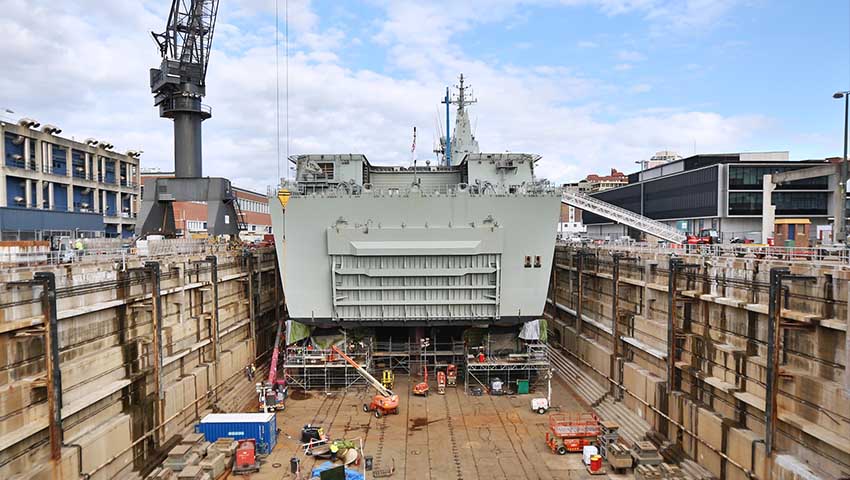With the Royal Australian Navy receiving a range of new surface ships and submarines, the fleet’s ashore sustainment, overhaul and repair facilities are going to come under increasing pressure to accommodate larger, more complex and capable vessels during standard operations, let alone in the event of major conflict, raising serious questions about the nation’s capacity to maintain and support the fleet.
To continue reading the rest of this article, please log in.
Create free account to get unlimited news articles and more!
Since the earliest days of European settlement, Sydney has served as the basis of Australia's naval forces – when the facilities at Garden Island passed to the Royal Australian Navy in 1911, the future Fleet Base East would rapidly evolve to become the single most important naval infrastructure for Australia. Incorporating both berthing facilities and the Captain Cook Graving Dock, which has served as the nation's only dry-dock facility.
While the advent of the 'Two Ocean' policy in the late 1980s saw the rapid development of HMAS Stirling in Perth as Fleet Base West, resulting in the single largest force posture shift for the Royal Australian Navy since the end of the Second World War.
Driven by the evolving geo-political, economic and strategic environment throughout the Indo-Pacific during the waning years of the Cold War, this major force posture restructure and major investment in the estate infrastructure of the Royal Australian Navy positioned the force to rapidly respond to the operational needs unique to the west coast.
With $90 billion worth of naval shipbuilding programs, the Royal Australian Navy and naval shipbuilding industry appears to be in an enviable position, this major recapitalisation and modernisation of major fleet units beginning with the Canberra Class amphibious warfare ships and the Hobart Class guided missile destroyers has now expanded to include the future Hunter Class guided missile frigates, Supply Class auxiliary vessels, the Arafura Class offshore patrol vessels and the future Attack Class submarines – each with their own unique and increasingly complex maintenance, sustainment and repair requirements.
As a maritime nation, Australia is dependent on unlimited access to the ocean – as the regional paradigm changes, there is greater strain on the Navy to protect the national interests and naval assets like the Canberra Class amphibious warfare ships, combined with concerns about the continuity of Australia's sovereign naval shipbuilding industry in between major programs.
Now, for the first time in the nation's history, Australia's prosperity, security and way of life is intrinsically linked to the ambition, stability and direction of its Indo-Pacific neighbours. Guaranteeing this requires the nation to find a balance between the expeditionary and interventionist focused 'Forward Defence' and the continental defence focused 'Defence of Australia' doctrines to counter the high and low intensity threats to the nation's security and interests.
Further to this, the thinly defined concepts of 'sovereign' and 'sustainable' as they relate to Australia's naval shipbuilding leave many unanswered questions, as does the ever-present spectre of the infamous 'valleys of death' between major projects that severely impact the capability, sustainability and cost of delivering major naval platforms – raising important questions about the ashore infrastructure needed to support both Australian and allied naval assets.
Maximising naval shipbuilding centres of excellence
The Australian government has committed itself to the single largest recapitalisation and modernisation program in the recent history of the Royal Australian Navy, also seeing the long-term economic and industrial benefits of developing a robust, sovereign industrial capability and naval shipbuilding capacity, however one of the critical force multiplying factors has been overlooked: critical ashore maintenance, sustainment and modernisation infrastructure.
Additionally, as larger numbers of allied naval assets, including US Navy amphibious warfare ships, guided missile destroyers, nuclear powered submarines and, potentially, nuclear powered aircraft carriers, continue to rotate through Australian ports, the capacity of Australia's limited naval sustainment, maintenance and overhaul infrastructure will face increased burden, limiting Australia's capacity to 'value add' in a contemporary threat environment.
Expanding the existing naval shipbuilding, maintenance and sustainment facilities at key locations like Williamtown in Victoria, Port Adelaide, and Henderson in Western Australia provides Australia with the opportunity to maximise its impact as an ally, providing reliable and sustainable maintenance, sustainment and repair facilities for both Australian and allied vessels while also supporting industry through increased access to naval platforms requiring varying degrees of maintenance and sustainment.
While costly, developing comparable naval maintenance and sustainment infrastructure at these key locations can also be done in partnership with key allies, namely the US, as has recently been announced for Darwin and the expansion of joint facilities in the strategic city – doing so provides additional value add for Australian industry and strategic multipliers, including giving the nation access to supporting nuclear powered vessels, with additional economic flow-on effects for the cities in which such hubs are established.
Your thoughts
Developing and implementing a cohesive, innovative and long-term vision for Australia's sovereign defence industry capability and the naval shipbuilding industry as a whole can also serve as the basis for developing, and in some cases redeveloping, a robust, advanced manufacturing economy taking advantage of Australia's unrivalled resource wealth – supporting the broader national security and interests in the Indo-Pacific.
So, let's ask the question, what is the long-term goal for Australia's naval shipbuilding industry and capability, what does it look like and what does it involve? How can Australian industry work collaboratively with government beyond the 2030s? Should continuous actually mean continuous research, design and development, and construction? What role does sustainment, maintenance and deep-repair play in this equation?
Let us know your thoughts and ideas supporting the next stages of development for Australia's sovereign defence capability in the comments section below, or get in touch with
Stephen Kuper
Steve has an extensive career across government, defence industry and advocacy, having previously worked for cabinet ministers at both Federal and State levels.

 Login
Login








